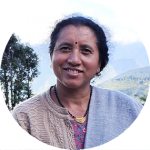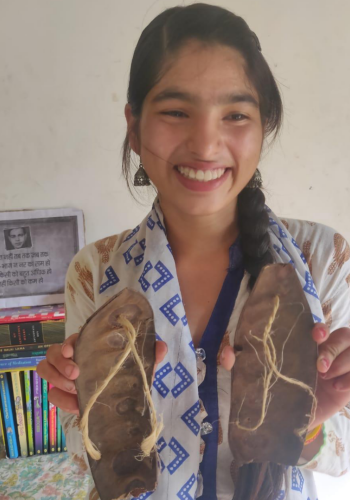
Khaturva- A celebration of cattle holding in Kumaon, Uttarakhand
Storyteller- Basanti Rawat
Village Sarmoli, Munsiari, District Pithoragarh
Uttarakhand
Read this story in Hindi
I was born 46 years ago in a farming family in Sarmoli village of Pithoragarh district in Kumaon. We were a joint family in which 16 members lived together. Our entire family was dependent on animal husbandry and farming. Today, like my parents, I also now keep cows and farm.

When I first began living in my in-laws’ house in Shankhadhura, I started with keeping one cow. Because of a growing shortage of milk for the household, I slowly raised the number of cows to four. My cows are as dear to me as my own children. I still remember the names of those first four cows – Dhauli, Kali, Ratuli, and Furkuli. I began selling their milk and with time my earnings from this livelihood started to increase. Today, as my health does not support me, I keep only two cows. The name of the older cow is Pinky and the younger one is called Rani. To tell the truth, Pinky and Rani are like my daughters. When you spend a large part of your day with these animals, you tend to develop a special attachment to them.

There is a special festival dedicated to cattle in our village that is called Khatarva or Khundru in our tongue. This festival is celebrated in the entire Kumaon region, though I have heard that it is not celebrated in Garhwal. According to the prevalent folklore, once upon a time there was a war between Kumaon and Garhwal in which our commander defeated the commander named Khatarva of the Garhwal army, and this festival is celebrated to rejoice this victory. Jimdars (farmers) and Bhotiyas (tribal people) of our village celebrate this festival together.

When we were young, my younger siblings and I used to eagerly wait for the Khatarva festival. This festival is celebrated every year on first day of Asoj (month of September). The interesting thing is that it is celebrated in different ways in different parts of Kumaon. This is the biggest festival of animals in which we pray for their long life and safety. It is believed that after this festival, Chaumas (the rainy season) ends and winter begins. From the day of Khatarva the roots of grasses in the forest begin to dry up. That is why we cut a lot of grass for our cows a day before, and cutting grass on the day of Khatarva is considered inauspicious for the cows. After this day the grass growing in the forest continue to dry and go yellow.

On the day of Khatarva, we children used to wake up early and go to the forest to collect walnuts. When we returned home, everyone would come together to bathe and groom the cow and prepare for its puja (prayer). Even today I remember how the sound of bells would ring and echo across the entire village. At the time, people in the village used to keep big bulls. All of us children were very excited that we would be going to the forest and would have a lot of fun!

After reaching the forest, the village children would round up the bulls and make them fight each other. Many a times the bulls’ horns would break in this fight. Children would play hide and seek together. Once a child got stuck in a tree and was scared to climb down. All the children tied their scarves together to make a rope and rescued the child. Four decades back, all the houses in our village kept cows and buffaloes. In those days, a cowherd was hired to take the cows out to graze in the village forest. The name of the cowherd of our village was Kundan. The people of the entire village fondly called him Lot Da. When Lot Da grew old, the villagers began taking their own cows out to graze. Today, very few people in the village take their animals to the forest and no one works as a cowherd. Animal husbandry has reduced, milk is bought from market dairy and farming has also taking a beating.

On the day of the festival, our cows are worshiped and we put oil and a teeka (vermillion) on their foreheads. Just as we wear new clothes on our teej tyohaar (festivals), similarly on the day of Khatarva, a rope made of hemp fibre is strung around the neck of all the animals. This rope is called dwal in the local language and a bell is tied to it. Nowadays people have started buying dwals made of plastic from the market for their cows.

Women make an effigy of a diety named Budi from freshly cut tall grass. Along with it, effigies of Budi’s children are also made. The cow dung pile is carefully covered with freshly cut grass. It is believed that when the cow manure heap is completely covered, the animals will not feel cold in winter. The Budi effigy is then placed on top of the cow dung heap. The Budi effigy is decorated with a variety of flowers and fruits such as apricots, walnut, cucumber and maize. Grass is spread over the path on which the animals are taken to the forest to graze.All the village children and cowherds go to the forest and clean the place. A temple is then built with stones. This place is decorated with flowers. Khaja prasad (dried puffed rice)is made and fruits are offered to the deity.

Children collect small stones in the shape of goats, cows, bulls and buffaloes and they are laid out in a circle. Grass is cut and placed before them to feed on. Small goat replicas are made of pumpkin, cucumber or lemon are placed in the shrine. After offering them to the deity, they are used to play the game of Bag-Bakri (the goat-leopard hunt). The goat replica is then slaughtered and offered to spirits in all four directions.

My neighbour Trilok Rana from Shankhdhura recalled how he used to celebrate this festival in his childhood –
“We used to take all the village cows and bulls to Khundru Paur (Khatarva shrine) built by our elders near Gwal Dhung (the Shepherds Rock). After circumambulating the shrine premises, we used to tie a big pumpkin with a rope and run around the premises dragging it. One of us would chase the pumpkin and beat it with the stick till we smashed it. The game was followed by the puja (prayer ceremony). Now only Anno from our village works as a cowherd and grazes his cows in the forest commons– others have only one or two cows and prefer to keep them at home.”

Beena Nitwal, who married into our village 20 years ago from the neighbouring Bageshwar district, recalls-
“We also used to bathe, oil and propitiate our cows, prepare the buri grass effigy and offer cucumber fruit and flowers. In the evening, when the cows and calves would come home, we would light a fire torch and take the smoking torch to everyone’s cowshed and shout –
“Khundru Khundru bahar nikal! (Khundru-Khundru get out!)”
Children would take two cloth bags and go to every house of the village to collect Khaja and cucumber. They would raise the war cry-
“Khundru har ge – gur jeet gae! (Khundru was defeated – the cow won!)”
“In the evening, we used to go to ridge above the village where we had made the Khundru Paur (a small shack made of pine needles and wood) during the day. We would arrange stones that looked like goats and cows in a circle. A replica of a jitti (a male buffalo calf) would be made from pumpkin and was sacrificed. Only then the Khundru Paur was set alight and burnt. We would eat the roasted maize by the side of the fire and distribute cucumber and khaja to everyone. The games that followed were hectic with all of us running, pushing and shoving, snatching the corn from each other and shouting in glee- Khundru Haar Ge – Gur Jeet Gae! I still don’t know why we used to do this but it was a lot of fun. No one does this anymore.”

In Shankhdhura village, Khundru Paur is not first built and then burnt, perhaps because it is the sacred land of the Mesar deity. Here, after the puja, prasad (blessed food offering) of Khaja, fruit and cucumber are distributed to all. Everyone also takes prasad home for their family members.

Cattle has a special significance in the life of us mountain folk. The farmyard manure and compost we apply to our fields, the milk and curd we give to our children– we get all of this from our animals. I believe that we celebrate our cows because they are not just a source of livelihood for us, but it is a way of expressing our love and gratitude towards them.

Over the years and with changing lifestyles, many aspects of our cultural heritage are getting lost. People have also reduced rearing livestock. If we stop keeping cattle, where will we get the manure and compost to nourish our fields, and how will we be able to continue doing our agricultural work?

Meet the storyteller






